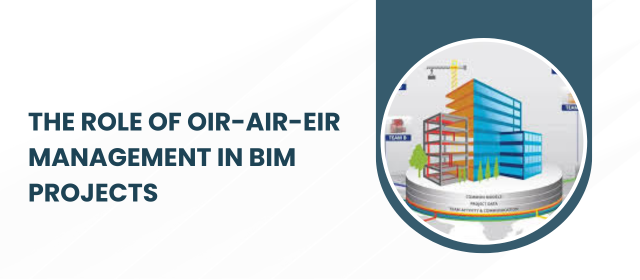The Role of OIR-AIR-EIR Management in BIM Projects
Effective control of data and exchange are critical to the successful conclusion of initiatives enabled by Building Information Modeling (BIM). Employer’s information requirements (EIR), asset information needs (AIR), and information about the organization requirements (OIR) are the three main pillars that are necessary to do this. Together, these structures make sure that users have access to relevant details at the right time, which is crucial for achieving mission alignment, minimizing risks, and abiding by industry norms such as PAS1192 and ISO19650. Construction success, appropriate asset management, and strategy for the future are all insured by the effective management of these frameworks.
You can also read this: Digital Engineering Consultants | Joseph Engineering Services (jesbim.com)
OIR, AIR, and EIR: What Are They?
Requirements for Organizational Information (OIR):
The strategic data demands of a business are the primary goal of OIR. It assures that assets are handled effectively throughout their lifecycle and supports a company in defining the information needed to accomplish its goals for the future. OIR lays the foundations for the use of information at different project stages by resolving overarching objectives of the company, which influences future allocation of funds and choices.
Requirements for Asset Information (AIR):
The specific data needed to manage material possessions both before and after development is described in AIR. Its main goal is to make sure that thorough asset knowledge is obtainable to facilitate continuing upkeep, repairs, and enhancements. The architecture provided offers complete details on every project component, permitting smoother asset transfers. This aids in preserving the efficient operation and durability of projects or facilities for building administrators and the owners of assets.
Information Requirements for Employers (EIR):
Throughout the project lifespan, EIR is essential for outlining what the employer wants. It specifies the information that the hiring manager requires, who is in charge of supplying it, and when it must be delivered. EIRs guarantee openness and lower the possibility of misconceptions by outlining the objectives that project teams have to accomplish. Everyone working on the project is certain that they understand their duties and responsibilities according to this straightforward structure.
How Project Success Is Driven by OIR-AIR-EIR Management
Documentation that is organized and straightforward
Straightforward record generation is one of the greatest advantages of OIR, AIR, and EIR management. By offering organized rules, these frameworks help consumers, vendors, and other interested parties avoid misunderstandings. The likelihood of delays based on unclear desires or unfinished outputs is reduced when every person involved has access to clearly specified specifications. Project teams may interact better and produce better outcomes when there is thorough documentation.
Better Lifecycle Organizing and Management of Assets
Asset Information Requirements (AIR) improve the administration of assets for BIM projects. Team members on projects may make future repairs and improvements simpler by making sure that accurate and comprehensive asset data is recorded during the building process. By doing this, companies may manage things more effectively throughout the course of their entire existence.
Making Informed Decisions:
Throughout the work, managing Employer’s Information Requirements (EIR) is crucial for reaching informed choices. In order to maintain the project on time and within budgetary constraints, the EIR structure makes sure that decision-makers are given access to the right data at the appropriate time. EIR management promotes team alignment by providing established tasks, duties, and objectives.
Risk Reduction and Standard Adherence:
Risk reduction is a major consequence of effective OIR, AIR, and EIR administration. The danger of legal and administrative problems that can result from inadequate information management is reduced by these platforms, which guarantee conformance to industry norms like ISO19650 and PAS1192. Conflicts minimize and 100% success is guaranteed when risks are proactively planned for through tightly regulated data requirements.
In conclusion:
For BIM projects to be profitable, OIR, AIR, and EIR must be managed correctly. These frameworks guarantee transparency and uniformity among participants by offering an organized method of handling information. Through enhanced asset management, improved cooperation, and conformity with global standards, OIR-AIR-EIR administration promotes achievement of projects and promotes the value over time.




